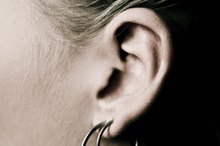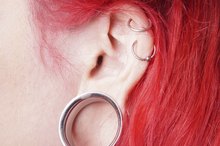What does fact checked mean?
At Healthfully, we strive to deliver objective content that is accurate and up-to-date. Our team periodically reviews articles in order to ensure content quality. The sources cited below consist of evidence from peer-reviewed journals, prominent medical organizations, academic associations, and government data.
The information contained on this site is for informational purposes only, and should not be used as a substitute for the advice of a professional health care provider. Please check with the appropriate physician regarding health questions and concerns. Although we strive to deliver accurate and up-to-date information, no guarantee to that effect is made.
Earaches and Cycling
Pain is a message from the body that something is wrong. When the pain occurs in your ears, it generally indicates an infection. The infection has little to do with bike riding, but cycling may aggravate the underlying condition, especially in cold weather. Ear problems need to be evaluated by a doctor and may require treatment.
If you are experiencing serious medical symptoms, seek emergency treatment immediately.
Ear Infections
Ear infections occur when bacteria, fungi or a virus build up in one of the air-filled spaces in the canal. Frequent ear cleaning with a foreign object, such as a cotton swab, may be the source. When the skin inside the ear canal becomes damaged, you are exposed to infection. Allergies and even the common cold can block the tubes that allow fluids to drain from the ear and lead to infection. Water that gets inside the passage from swimming or bathing often causes inflammation. Bike riding is not a sport associated with ear infections since there is no water submersion.
- Ear infections occur when bacteria, fungi or a virus build up in one of the air-filled spaces in the canal.
- When the skin inside the ear canal becomes damaged, you are exposed to infection.
Common Misconception
How to Get Rid of an Ear Lobe Infection
Learn More
It is a common misconception that exposure to cold air from bike riding will cause an ear infection. Cold weather will not lead to an ear infection, according to the McKinley Health Center. It may have an effect on your overall health and make you vulnerable to colds or the flu. Cold wind may also aggravate an already existing infection. This doesn't mean you should not protect your ears if you bike ride in inclement weather. If you have ear pain during these rides, it may be due to the freezing or wind burn on the outside of the ear.
- It is a common misconception that exposure to cold air from bike riding will cause an ear infection.
- If you have ear pain during these rides, it may be due to the freezing or wind burn on the outside of the ear.
Ear Protection
Covering your ears when biking in cold weather may prevent some of the pain. This is true regardless of the cause of the discomfort. A ski mask, or balaclava, works well for bikers because it is adjustable. As you ride, your body will heat up, and you may want to shed some of the protection. A balaclava can cover the head, face and neck at the beginning of the ride. Once you warm up, fold the mask up so it sits on top of your head like a hat. Keep the material pulled down far enough to cover your ears. Other options for ear protection includes ear muffs or a hat the pulls down over the ears.
- Covering your ears when biking in cold weather may prevent some of the pain.
- A balaclava can cover the head, face and neck at the beginning of the ride.
Expert Insight
How to Treat an infected ear piercing
Learn More
Ear pain is not something you should ignore, especially if it is persistent. Ear infections can damage the intricate structure of the middle and inner ear. This damage may have a lasting impact on your hearing. Untreated ear infections can spread to become life threatening. If you suffer from allergies, talk to your doctor about taking a nondrowsy antihistamine regularly to help reduce ear pain. If you bike ride at high elevations, ear pain may be due to barotrauma, or air pressure. Try chewing gum or yawning when riding to see if this eases the discomfort.
- Ear pain is not something you should ignore, especially if it is persistent.
- If you bike ride at high elevations, ear pain may be due to barotrauma, or air pressure.
Related Articles
Writer Bio
Writing since 1999, Darla Ferrara is an award-winning author who specializes in health, diet, fitness and computer technology. She has been published in "Mezzo Magazine" and Diet Spotlight, as well as various online magazines. Ferrara studied biology and emergency medical technology at the University of Nebraska and Southeast Community College.









